比较(七)利用python绘制表格
比较(七)利用python绘制表格
表格(Table)简介
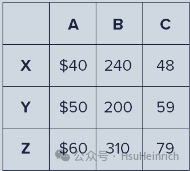
表格是数据在行和列中的结构化排列,允许进行方便的排序、过滤和分析。表格的优点在于可以清晰、有组织的呈现信息,便于快速比较和解读信息。
快速绘制
基于pandas
可能需要更新jinja2:pip install --upgrade jinja2
import pandas as pd
import matplotlib as mpl
import numpy as np
# 自定义数据
sample_size = 6
new_york = np.random.uniform(20,60,sample_size)
paris = np.random.uniform(20,40,sample_size)
london = np.random.uniform(5,30,sample_size)
df = pd.DataFrame({'new_york': new_york,
'paris': paris,
'london': london},
index=pd.date_range(start="2020-01-01", periods=sample_size).strftime("%d-%m-%Y"))
# 自定义风格函数
def custom_table(styler):
styler.background_gradient(cmap="Blues", axis=None) # 色阶
styler.format(precision=2)
# 文本格式
styler.applymap(lambda x: 'text-align: center; font-size: 14px;')
return styler
agg_metrics = df.agg(["mean", "max"]) # 增加统计数据
pd.concat([df, agg_metrics]).style.pipe(custom_table)
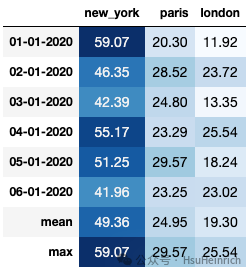
基于plottable
import matplotlib.pyplot as plt
import pandas as pd
from plottable import Table
# 自定义数据
data = {'Score': [8, 6, 10, 3, 9],
'Value': [50.42, 17.01, 42.90, 6.83, 92.06],
'Comment': ['Nice', 'Cool', 'Fun', 'Bad', 'Okay']}
df = pd.DataFrame(data)
# 初始布局
fig, ax = plt.subplots(figsize=(5, 5))
# 绘制表
tab = Table(df)
plt.show()
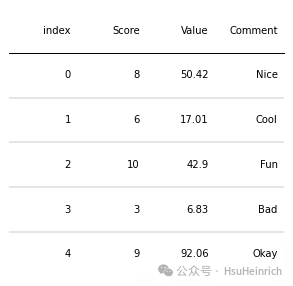
基于matplotlib
import pandas as pd
import matplotlib.pyplot as plt
import numpy as np
# 自定义数据
data = {'Freeze': [ 66386, 174296, 75131, 577908, 32015],
'Wind': [ 58230, 381139, 78045, 99308, 160454],
'Flood': [ 89135, 80552, 152558, 497981, 603535],
'Quake': [ 78415, 81858, 150656, 193263, 69638],
'Hail': [139361, 331509, 343164, 781380, 52269],
'rows': ['%d year' % x for x in (100, 50, 20, 10, 5)]}
df = pd.DataFrame(data)
values = np.arange(0, 2500, 500)
value_increment = 1000
# 调色板
colors = plt.cm.BuPu(np.linspace(0, 0.5, len(df)))
n_rows = len(df)
index = np.arange(len(df.columns)-1) + 0.3
bar_width = 0.6
# 条形堆叠图的垂直便宜
y_offset = np.zeros(len(df.columns)-1)
# 绘制条形图并为表格创建文本标签列表
cell_text = []
for row in range(n_rows):
plt.bar(index, df.iloc[:, row], bar_width, bottom=y_offset, color=colors[row])
y_offset = y_offset + df.iloc[:, row]
cell_text.append(['%1.1f' % (x / 1000.0) for x in y_offset])
# 反转颜色和文本标签以在顶部显示最后一个值
colors = colors[::-1]
cell_text.reverse()
# 在轴的底部添加一个表格
the_table = plt.table(cellText=cell_text,
rowLabels=df['rows'],
rowColours=colors,
colLabels=df.columns,
loc='bottom')
# 调整布局以为表格腾出空间
plt.subplots_adjust(left=0.1, bottom=0.1)
# 修改刻度标签
plt.ylabel(f"Loss in ${value_increment}'s")
plt.yticks(values * value_increment, ['%d' % val for val in values])
plt.xticks([])
plt.show()
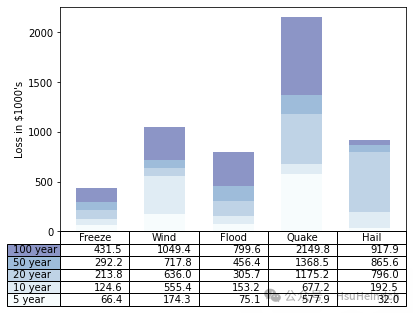
定制多样化的表格
自定义表格一般是结合使用场景对相关参数进行修改,并辅以其他的绘图知识。参数信息可以通过官网进行查看,其他的绘图知识则更多来源于实战经验,大家不妨将接下来的绘图作为一种学习经验,以便于日后总结。
plottable主要利用Table绘制表格,可以通过plottable[1]了解更多用法
# 导入相关库
import matplotlib.pyplot as plt
import pandas as pd
from plottable import Table
from plottable import ColumnDefinition
from matplotlib.cm import Blues
from plottable.plots import image, circled_image, bar, percentile_bars, percentile_stars, progress_donut
from plottable.formatters import decimal_to_percent
import matplotlib as mpl
plt.rcParams['font.sans-serif'] = ['SimHei'] # 用来正常显示中文标签
# 自定义数据
data = {'Score': [8, 6, 10, 3, 9],
'Value': [50.42, 17.01, 42.90, 6.83, 92.06],
'Comment': ['Nice', 'Cool', 'Fun', 'Bad', 'Okay']}
df = pd.DataFrame(data)
df.head()
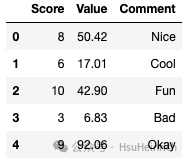
不同的修改行列方式
fig = plt.figure(figsize=(12,4))
# 单列修改:column_definitions
plt.subplot(1, 3, 1)
column_definitions = [ColumnDefinition(name='Score',
title='Score custom', # 自定义列名
textprops={"ha": "left", "weight": "bold"} # 文本格式
)]
tab = Table(df, column_definitions=column_definitions)
plt.title('单列修改:column_definitions')
# 全部列修改:Table参数
plt.subplot(1, 3, 2)
tab = Table(df, textprops={"ha": "left", "weight": "bold"}, # 文本格式
row_dividers=False, # 删除行之间的线
footer_divider=True, # 尾部添加参考线
)
plt.title('全部列修改:Table参数')
# 细节修改
plt.subplot(1, 3, 3)
tab = Table(df)
tab.columns["Score"].set_facecolor('lightblue') # 自定义列
tab.rows[1].set_fontcolor('green') # 修改颜色
plt.title('细节修改')
plt.show()
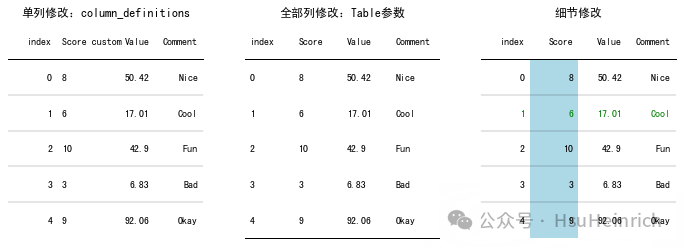
自定义颜色
fig = plt.figure(figsize=(12,8))
# 修改单列颜色
plt.subplot(3, 2, 1)
tab = Table(df)
tab.columns['Value'].set_facecolor("lightblue")
tab.columns['Score'].set_fontcolor("green")
plt.title('修改单列颜色')
# 修改全部颜色
plt.subplot(3, 2, 2)
tab = Table(df)
for col in df.columns:
tab.columns[col].set_facecolor("lightblue")
tab.columns[col].set_fontcolor("red")
plt.title('修改单列颜色')
# 修改单行颜色
plt.subplot(3, 2, 3)
tab = Table(df)
tab.rows[1].set_facecolor("lightblue")
tab.rows[2].set_fontcolor("red")
plt.title('修改单行颜色')
# 修改全部行颜色
plt.subplot(3, 2, 4)
tab = Table(df,
even_row_color='lightgrey',
odd_row_color='orange')
plt.title('修改全部行颜色')
# 单列渐变色
plt.subplot(3, 2, 5)
tab = Table(df,
column_definitions=[ColumnDefinition(name="Score", cmap=Blues)])
plt.title('单列渐变色')
plt.show()
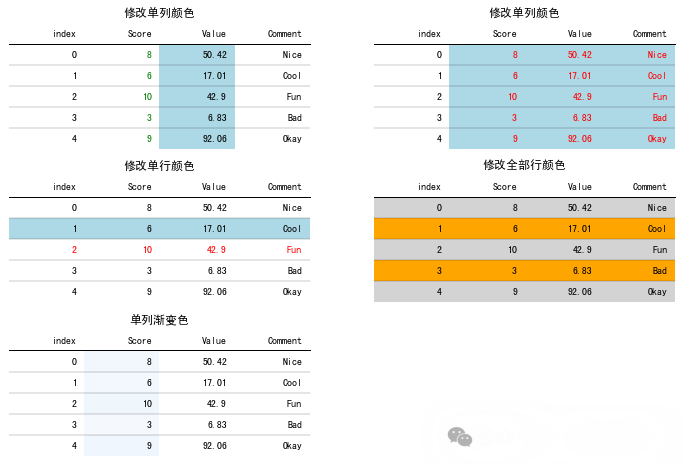
插入图片
# 自定义数据
data = {'Score': [3, 12, 5, 7, 10],
'Comment': ['Fun', 'Okay', 'Nice', 'Bad', 'Cool'],
'Image': ['python', 'apple', 'apple', 'python', 'apple']}
df = pd.DataFrame(data)
# 修改Image,增加前后缀拼出路径
df['Image'] = df['Image'].apply(lambda x: x+'.png' if '.png' not in x else x)
df['Image'] = df['Image'].apply(lambda x: 'pic/'+x if 'pic/' not in x else x)
fig = plt.figure(figsize=(8,5))
# 插入图片
plt.subplot(1, 2, 1)
plt.title('插入图片')
coldef = [ColumnDefinition(name="Image",
textprops={"ha": "center"},
width=0.5,
plot_fn=image)]
tab = Table(df, column_definitions=coldef)
# 插入图片-圆形图像
plt.subplot(1, 2, 2)
plt.title('插入图片-圆形图像')
coldef = [ColumnDefinition(name="Image",
textprops={"ha": "center"},
width=0.5,
plot_fn=circled_image)]
tab = Table(df, column_definitions=coldef)
plt.show()
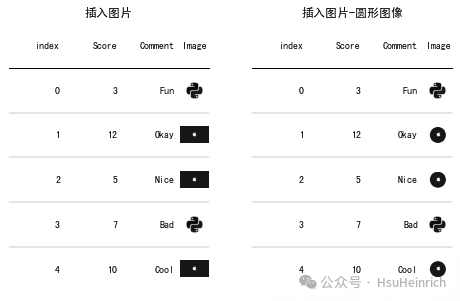
在表格中绘图
# 自定义数据
data = {'Score': [82, 68, 17, 39, 91],
'Value': [82, 68, 17, 39, 91],
'Metric': [82, 68, 17, 39, 91],
'KPI': [82, 68, 17, 39, 91]}
df = pd.DataFrame(data)
df = df/100
fig = plt.figure(figsize=(12,8))
# 绘制bar百分比
plt.subplot(3, 2, 1)
plt.title('绘制bar百分比')
tab = Table(df,
textprops={"ha": "center"},
column_definitions=[ColumnDefinition("Score",
plot_fn=percentile_bars,
plot_kw={"is_pct": True})]
)
# 绘制星星百分比
plt.subplot(3, 2, 2)
plt.title('绘制星星百分比')
tab = Table(df, cell_kw={"linewidth": 0, "edgecolor": "k"},
textprops={"ha": "center"},
column_definitions=[ColumnDefinition("Value",
plot_fn=percentile_stars,
plot_kw={"is_pct": True})]
)
# 绘制甜甜圈进度
plt.subplot(3, 2, 3)
plt.title('绘制甜甜圈进度')
tab = Table(df,
textprops={"ha": "center"},
column_definitions=[ColumnDefinition("Metric",
plot_fn=progress_donut,
plot_kw={"is_pct": True,
"formatter": "{:.0%}"})])
# 绘制进度条
plt.subplot(3, 2, 4)
plt.title('绘制进度条')
cmap = plt.get_cmap('viridis')
tab = Table(df,
textprops={"ha": "center"},
column_definitions=[ColumnDefinition("KPI",
plot_fn=bar,
plot_kw={"cmap": cmap,
"plot_bg_bar": True,
"lw": 0.5})]
)
# 各种百分比进度条
plt.subplot(3, 2, 5)
plt.title('各种百分比进度条')
cmap = plt.get_cmap('viridis')
col_defs = [ColumnDefinition("Metric", plot_fn=progress_donut, plot_kw={"is_pct": True,
"formatter": "{:.0%}"}),
ColumnDefinition("Value", plot_fn=percentile_stars, plot_kw={"is_pct": True}),
ColumnDefinition("Score", plot_fn=percentile_bars, plot_kw={"is_pct": True}),
ColumnDefinition("KPI", plot_fn=bar, plot_kw={"cmap":cmap,
"plot_bg_bar": True,
"lw": 0.5})
]
tab = Table(df, cell_kw={"linewidth": 0, "edgecolor": "k"},
textprops={"ha": "center"},
column_definitions=col_defs)
plt.show()
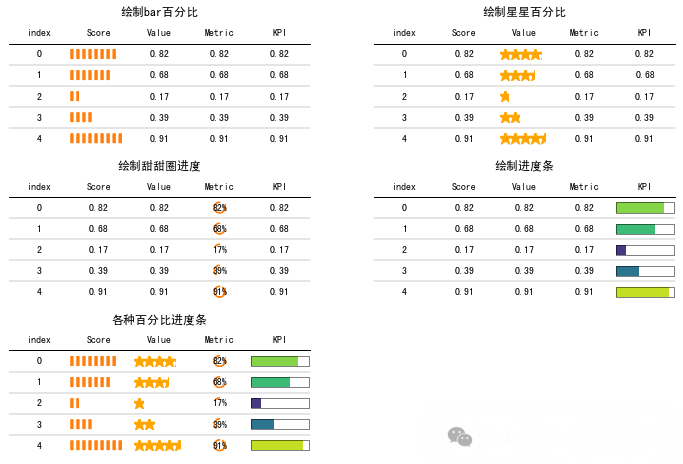
总结
以上通过pandas的styler方法绘制独具风格的表格,这里推荐使用plottable快速绘制表格,并通过相关方法和参数自定义多样化的表格。
参考资料
[1]
plottable: https://plottable.readthedocs.io/en/latest/
本文参与 腾讯云自媒体同步曝光计划,分享自微信公众号。
原始发表:2024-07-15,如有侵权请联系 cloudcommunity@tencent.com 删除
评论
登录后参与评论
推荐阅读
目录
